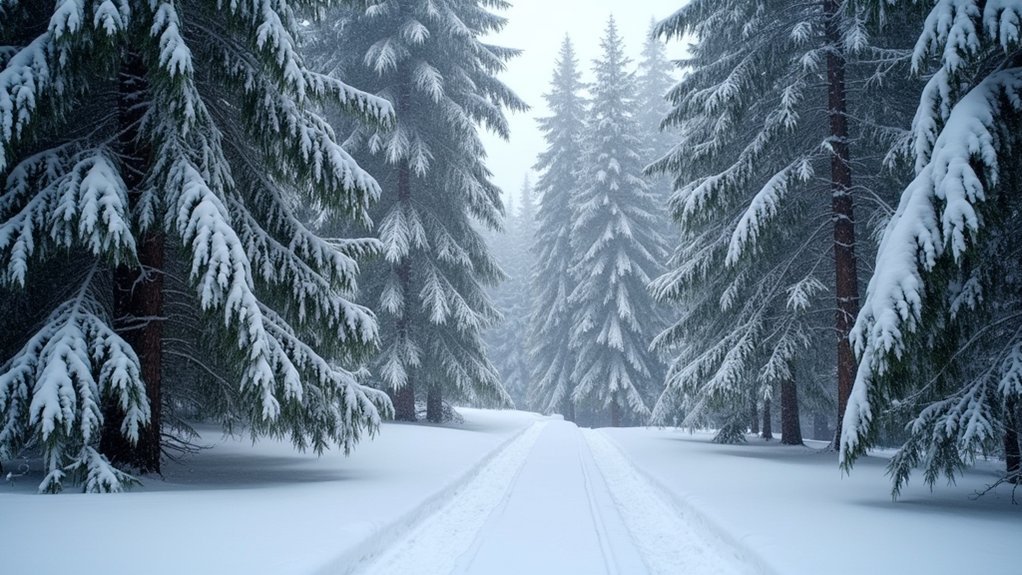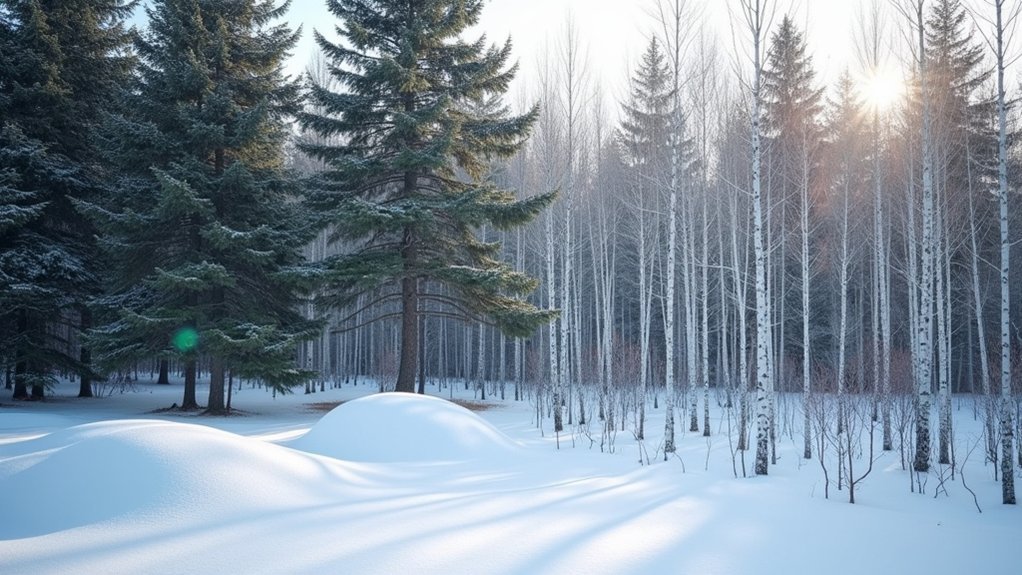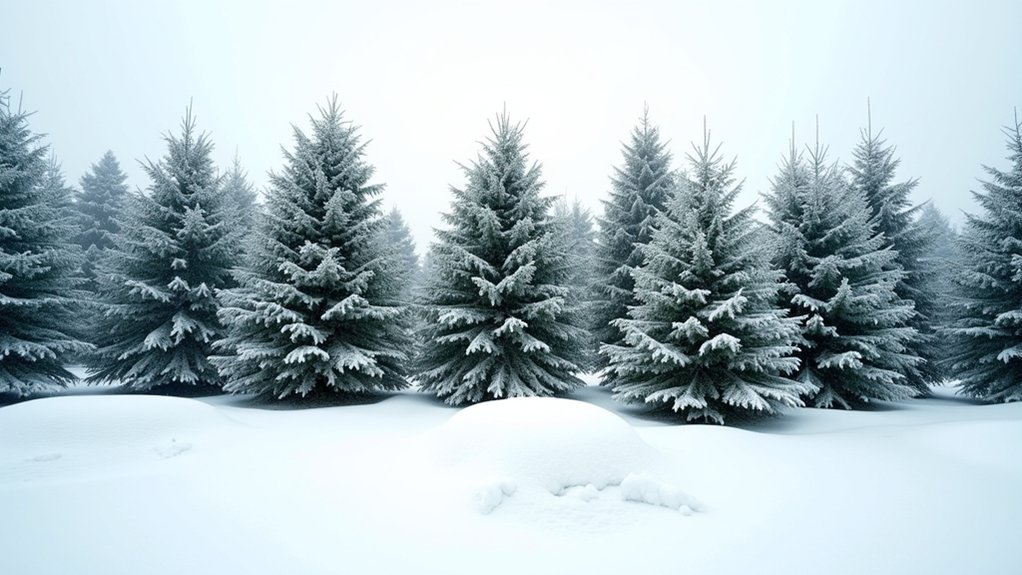Evergreen conifers like Norway Spruce create effective snow barriers, trapping drifts before they reach critical areas. Plant these trees in staggered double rows about 150 feet upwind of areas needing protection, spacing them 20-25 feet apart for ideal density. You’ll get best results with a mix of evergreens and deciduous trees, creating a barrier with approximately 65% density. The right tree placement can transform your winter landscape management with minimal ongoing maintenance.
Understanding How Trees Block Snow and Control Drifting

When winter winds sweep across open landscapes, strategically planted trees become natural barriers against blowing snow. Dense evergreen conifers like pines and spruces effectively reduce wind velocity, causing snow to drop before it can drift across your property.
Trees and shrubs function as windbreaks that reduce heat loss while controlling snow accumulation. The most effective protection comes from properly placed shelterbelts—multiple rows of trees creating a 65% density barrier that disrupts airflow without creating excessive turbulence.
This causes snow to deposit in a predictable pattern extending up to five times the height of your trees on the downwind side.
For ideal results, space conifers 20-25 feet apart and deciduous trees 12-20 feet apart, maintaining buffer zones that capture drifts while improving moisture management around your property.
Best Coniferous Trees for Year-Round Snow Protection
Evergreen density serves as your primary consideration when selecting conifers like Norway Spruce, which offers exceptional wind resistance with its thick, layered branches even in harsh winter conditions.
You’ll achieve maximum protection by placing these trees on your property’s windward side, where they’ll intercept snow before it reaches driveways, walkways, or buildings.
For ideal results, plant your conifers 20-25 feet apart in a double row configuration, creating a natural snow fence that traps winter precipitation before it reaches critical areas.
Evergreen Density Matters
Because effective snow barriers depend largely on foliage density, not all evergreens offer equal protection against winter’s harsh elements. When selecting trees for snow control, aim for varieties with a density of at least 65%.
Twin rows of tightly-packed evergreen trees create the ideal windbreak structure.
The densest evergreens—like Norway spruce and Thuja ‘Green Giant’—provide superior wind protection with their thick, year-round foliage. These powerhouse varieties can reduce wind velocity dramatically, preventing snow from drifting around your home or driveway.
For maximum effectiveness, plant your evergreen trees in a staggered formation, spacing them 20-25 feet apart. This arrangement creates a seamless barrier of dense foliage that can extend snow protection up to 20 times the height of your trees.
Norway Spruce Strengths
The Norway spruce stands as the undisputed champion among coniferous trees for snow protection, combining rapid growth with exceptional durability.
You’ll appreciate how quickly these conifers establish effective windbreaks, growing 1-2 feet annually and reaching impressive heights of 40-60 feet when mature.
What makes Norway spruce particularly valuable for controlling snow drifts is its dense, conical structure and flexible branches that withstand heavy snow loads without breaking.
When planted in tight rows, they create an impenetrable barrier that redirects drifting snow away from your property.
Hardy in USDA zones 3-7, these adaptable trees thrive in various soil conditions, making them suitable for most landscapes.
Their evergreen foliage not only blocks snow year-round but also provides wildlife habitat and visual interest through all seasons.
Windward Placement Strategy
Strategic positioning on your property’s windward side represents the cornerstone of effective snow management with coniferous trees. By planting Norway spruce, eastern white pine, or Colorado blue spruce facing the prevailing winds, you’ll create a natural barrier that disrupts wind patterns and considerably reduces snow accumulation in protected areas.
For peak effectiveness, aim for a windbreak density of 50-65%, achievable with two staggered rows of evergreen trees. Space your conifers 20-25 feet apart to guarantee healthy growth while maximizing their snow-blocking potential. This arrangement can reduce wind speed by up to 50%, minimizing drift formation.
Consider combining fast-growing varieties like Leyland cypress with slower-growing species for both immediate and long-term protection. This mixed approach creates a robust windward barrier that provides year-round snow control while securing the longevity of your protective tree line.
Deciduous Options for Seasonal Wind and Snow Management
While coniferous trees offer year-round protection, you’ll find deciduous varieties can still play an essential role in your snow management strategy.
You can create effective seasonal wind barriers by planting varieties like viburnum and oak in clusters, allowing them to control wind patterns and direct snow drifts away from your driveways and walkways.
For best results, combine your deciduous windbreaks with a thoughtful fall-to-spring protection plan that incorporates both tree types at a 1:10 height-to-distance ratio.
Deciduous Wind Barriers
Despite losing their leaves in winter, deciduous trees can provide surprisingly effective protection against snow drift when placed strategically around your property. Species like viburnum and oak break the force of wind, reducing snow accumulation around structures in areas prone to heavy snowfall.
For peak effectiveness, plant your deciduous trees in staggered formations to create stronger windbreaks against drifting snow. Remember that a properly designed barrier can reduce wind speeds and snow drift up to 20 times the height of the trees. Consider both height and density when selecting your varieties.
For ideal protection year-round, you’ll benefit from combining deciduous trees with evergreens in your windbreak design. This mixed approach guarantees continuous coverage while minimizing snow accumulation in vulnerable areas of your property.
Fall-to-Spring Protection Strategies
When planning for year-round snow management, consider how deciduous trees offer unique benefits across changing seasons.
Position your deciduous windbreaks at least 150 feet upwind from areas needing protection to effectively control drifting without blocking access routes.
Red oak and sugar maple create dense canopies that reduce wind speed while minimizing snow accumulation around driveways and structures.
In winter, these trees lose their leaves, allowing sunlight to warm the ground while still providing windbreak protection during critical fall and spring months.
For maximum effectiveness, combine deciduous trees with evergreen species.
This strategic pairing guarantees year-round benefits—evergreens block harsh winter winds while deciduous components manage seasonal drift patterns.
This combination also promotes beneficial snow retention, enhancing groundwater replenishment when temperatures rise.
Strategic Placement of Trees to Minimize Snow Accumulation

To effectively block snow from accumulating in unwanted areas, you’ll need to strategically position your trees rather than planting them randomly.
Place your windbreaks approximately 150 feet upwind from areas you want to protect, following the direction of prevailing winds. This distance optimizes their effectiveness for controlling drifts and reducing snow removal needs.
Arrange trees planted in a staggered double-row configuration, which creates turbulence that forces snow to drop before reaching your protected areas.
Maintain a 1:10 height-to-distance ratio for maximum efficiency. Space conifers 20-25 feet apart, mixing evergreens with deciduous shrubs for year-round protection and aesthetic appeal.
This strategic approach guarantees that your trees not only block snow but also create a functional landscape that minimizes winter maintenance.
Multi-Row Shelterbelt Design for Maximum Effectiveness
While single or double-row configurations offer good protection, multi-row shelterbelts represent the gold standard for snow management on larger properties. For peak effectiveness, place your shelterbelt about 150 feet upwind from areas you want to protect.
The ideal multi-row shelterbelt design combines deciduous shrubs with coniferous trees to achieve 50-65% density. This combination traps snow efficiently while allowing some wind to filter through.
Space your coniferous trees 20-25 feet apart both within rows and between rows to promote healthy growth and maximize snow catchment.
Don’t forget to trim the lower branches of your trees to 10-20% of their height. This prevents snow clogging at the base and improves the shelterbelt’s ability to control drifts by lifting wind currents and redirecting snow deposition.
Spacing and Density Considerations for Snow Barrier Trees

Proper spacing between trees forms the foundation of any effective snow barrier system. For ideal snow control, space conifer trees 20-25 feet apart and deciduous trees 12-20 feet apart to achieve the recommended 50-65% density that blocks snow while allowing wind to filter through.
| Tree Type | Spacing | Density Impact |
|---|---|---|
| Conifers | 20-25 ft apart | High winter protection |
| Deciduous | 12-20 ft apart | Moderate filtering |
| Shrubs | 3-6 ft in row | Creates lower barrier |
| Mixed plantings | 6-10 ft between rows | ideal 50-65% density |
| Fast/slow growers | Variable | Sustainable protection |
When incorporating shrubs, place them 3-6 feet apart within rows and 6-10 feet between rows. Remember that your barrier’s protective zone extends roughly 10 times the height of your trees, making taller species more effective for larger areas.
Maintenance Requirements for Snow-Blocking Tree Barriers
Although snow-blocking tree barriers require minimal upkeep compared to other landscaping features, they still need strategic maintenance to remain effective.
Native species generally thrive with little intervention once established, making them ideal low maintenance options for your snow barrier.
Native plants offer nature’s own solution for snow barriers—minimal care with maximum protection for your property.
You’ll need to provide irrigation during the first year after planting, especially in drier areas, to guarantee proper root development.
For fast-growing conifers, regular pruning maintains their shape and snow-blocking efficiency.
Don’t overlook potential pest and disease issues—monitor your trees periodically, as infestations can compromise your barrier’s effectiveness.
Selecting xeric (drought-tolerant) and native plants adapted to your local conditions will greatly reduce your overall maintenance workload while guaranteeing your snow barrier performs at its best year after year.
Native Tree Species for Regional Snow Control Applications

Now that you understand maintenance considerations, selecting the right native trees for your specific region will maximize your snow barrier’s effectiveness.
Native tree species like Eastern Red Cedar provide dense foliage that effectively reduces wind speed and promotes controlled snow deposition away from your property.
For ideal snow retention, consider planting Quaking Aspen and other deciduous natives that create sturdy windbreaks, trapping snow before it can drift onto roads or structures.
Mixing conifers such as White Pine or Norway Spruce with deciduous varieties offers year-round protection while minimizing winter accumulation where it’s unwanted.
Native trees offer the significant advantage of being well-adapted to local conditions, resulting in higher survival rates during extreme weather and lower maintenance demands—all while supporting local wildlife and biodiversity.
Combining Trees and Shrubs for Comprehensive Drift Management
Creating an effective snow barrier requires more than just planting a single row of trees.
You’ll achieve ideal drift control by combining evergreen trees with dense foliage, like pines and spruces, with deciduous shrubs planted strategically between them. This layered approach acts similarly to living snow fences, capturing more snow and reducing drifts.
For maximum effectiveness, design your windbreak using three or more rows: evergreens spaced 20-25 feet apart in the primary row, with shrubs like viburnum or fruiting quince planted 3-6 feet apart in secondary rows.
This combination extends your protected zone up to 20 times the height of your windbreak. Including diverse native plants improves resilience against pests while supporting wildlife.
Fast-growing species like Leyland cypress provide immediate benefits while slower-growing plants guarantee long-term protection.
Frequently Asked Questions
How Do You Prevent Snow Drifts in Landscaping?
You’ll prevent snow drifts by planting windbreaks with evergreen trees like pines and spruces. Space them in dense clusters with 50-65% density, positioned at least 150 feet from protected areas for maximum effectiveness.
How to Prevent Snow Drifts?
To prevent snow drifts, you’ll need strategic barriers. Plant dense evergreen windbreaks 20 times their height from protected areas. Use fences with 50-65% density or staggered tree rows combining deciduous and coniferous varieties for ideal control.
What Is the Fastest Growing Tree for Windbreak?
Thuja ‘Green Giant’ is your fastest windbreak option, growing 3-5 feet yearly and reaching 30-40 feet at maturity. You’ll also find Leyland cypress impressive, as it quickly reaches 50-60 feet with minimal maintenance.
What Is the Best Tree for a Shelterbelt?
For shelterbelts, you’ll find coniferous evergreens like pines, spruces, and cedars are your best options. They’re effective year-round and provide dense foliage. Consider planting multiple rows with evergreens on the outside for maximum protection.
In Summary
By strategically planting conifers like spruce and pine alongside deciduous options such as poplar and willow, you’ll effectively control snow drifts on your property. Remember to position multiple rows of trees perpendicular to prevailing winds, maintaining proper spacing for airflow. You’ll need regular maintenance to guarantee your living snow fence remains effective. For best results, combine trees with shrubs and consider native species adapted to your local climate conditions.





Leave a Reply